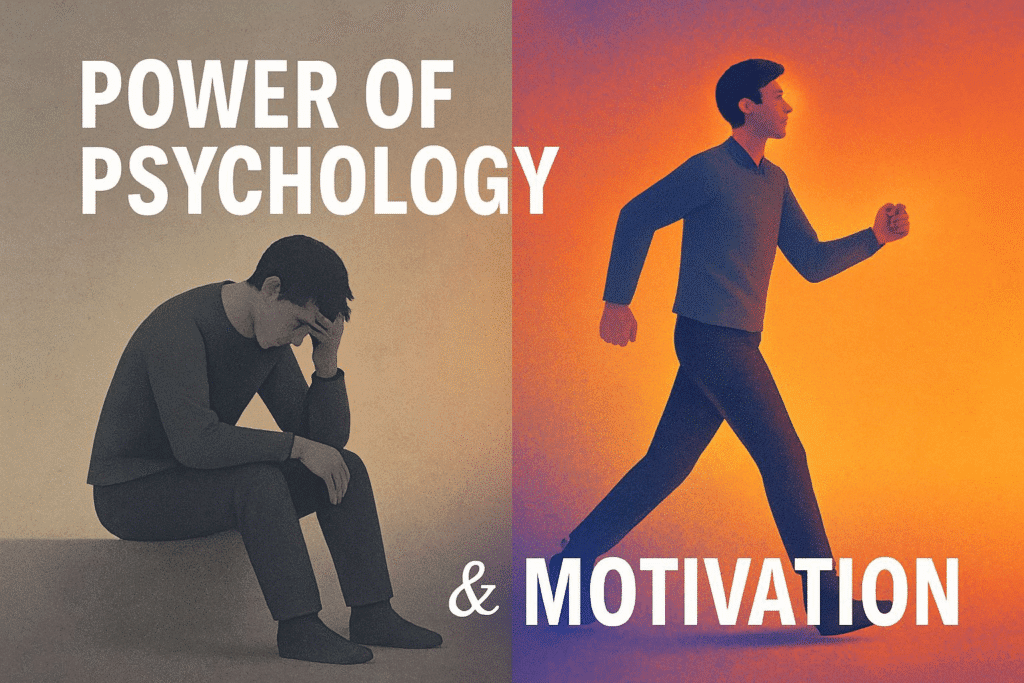Introduction

Every significant leap in life — whether it’s launching a business, acing an exam, or simply getting out of bed with purpose — begins with a single invisible force: motivation. But what exactly is this driving energy, and why does it sometimes surge like a tidal wave, only to vanish without a trace on other days?
At its core, motivation is far more than just a fleeting sense of inspiration. It’s the internal engine that powers human behavior — the reason we chase ambitions, conquer obstacles, and grow beyond comfort zones. From the moment you decide to pursue a goal to the final push that makes it a reality, motivation is quietly shaping every step of the journey.
Yet, what many don’t realize is that motivation is deeply rooted in the science of the mind. It’s not magic; it’s a blend of neurology, psychology, and behavior patterns. Think of it as a system — one that interacts with your beliefs, emotional states, and even your environment. When this system aligns, you feel unstoppable. When it breaks down, even the simplest tasks can feel like climbing Everest.
This guide isn’t just about “staying motivated.” You’ve probably heard the same old advice: “set goals,” “stay positive,” or “visualize success.” Instead, we’re digging deeper. We’ll uncover how motivation actually works, how it evolves over time, and how to engineer it deliberately, even when you’re not “feeling it.”
Whether you’re on the brink of burnout, stuck in a rut, or simply curious about how high-performers sustain momentum — this blog will give you actionable strategies backed by research and real-world examples. You’ll walk away with insights that aren’t just inspiring — they’re transformational.
The Science Behind Motivation

We often treat motivation like a mood — something that comes and goes with the weather. But science tells a very different story. Motivation is not a mystery. It’s a measurable, explainable process rooted in psychology and neuroscience, influencing every decision we make and every goal we pursue. The more we understand it, the more control we have over it.
Let’s dive into the mechanisms behind this invisible yet powerful force.
1. Intrinsic vs. Extrinsic: The Two Engines of Drive
Motivation isn’t one-size-fits-all. It comes in two distinct forms, and understanding their differences is key to unlocking long-term consistency.
- Intrinsic Motivation is fueled by internal satisfaction. Think of the joy of mastering a language, solving a puzzle, or painting just for the love of it. There’s no external prize — the journey itself is the reward. This kind of motivation tends to be more sustainable because it’s emotionally fulfilling and deeply personal.
- Extrinsic Motivation, on the other hand, is driven by outcomes — promotions, praise, trophies, or financial gains. It’s effective for achieving short-term results, especially when clear incentives are at play. But when external rewards disappear, so can the drive.
🚀 The Sweet Spot? High achievers often combine both — leveraging external rewards to jumpstart momentum, but grounding their motivation in a personal sense of purpose for long-term stamina.
2. Your Brain on Motivation: A Dopamine-Driven Blueprint
Underneath the feelings of motivation lies a carefully orchestrated biological system. At the center of it is a chemical messenger: dopamine.
Here’s how it works:
- Anticipation Over Achievement: Surprisingly, dopamine spikes not when you achieve your goal, but when you anticipate it. This is what creates that drive to act — your brain is essentially saying, “Go get it!”
- The Reward Loop: Every time you complete a task, no matter how small, dopamine gives you a dose of satisfaction. Over time, this creates a feedback loop — do the task, get rewarded, repeat.
- Emotion Matters: Stress, fear, and negative thought patterns disrupt this loop. That’s why emotional well-being isn’t just “nice to have” — it’s crucial for staying motivated.
📌 Pro Tip: Want to “hack” your motivation system? Break large goals into micro-tasks. Each small win releases dopamine, keeping your motivation engine humming.
3. What Psychology Teaches Us About Staying Driven
Science doesn’t just explain motivation — it offers strategies to cultivate it. Several psychological theories offer insights into what drives human action:
- Maslow’s Hierarchy of Needs suggests that motivation flows from fulfilling a series of needs, starting with basics like safety and evolving toward self-actualization. You can’t focus on career goals if your emotional or financial needs are unmet.
- Self-Determination Theory (SDT) says we thrive when three conditions are met: we feel autonomous (in control), competent (capable), and connected (emotionally linked to others). These aren’t just ideals — they’re core human requirements for lasting motivation.
- Expectancy Theory explores the link between belief and action. If you genuinely believe that your effort will lead to a meaningful result, you’re far more likely to stay committed.
🧠 Mental Shift: Motivation doesn’t just show up. It’s often the result of belief systems, environmental design, and internal clarity.
Motivation and Goal Achievement

We all dream of better lives — whether that means building a thriving career, leveling up in school, or becoming the best version of ourselves. But dreams without action are just wishful thinking. That’s where motivation becomes a game-changer — it bridges the gap between ambition and achievement.
Let’s explore how motivation, paired with strategy and discipline, transforms goals into tangible results.
1. Progress Begins With Purpose
Motivation isn’t just a spark — it’s the fuel that keeps your goals alive. Without it, even the most exciting ambitions can fade into the background. But when you’re deeply connected to why you’re doing something, motivation becomes more than just a feeling — it becomes a force.
🔥 How to activate it:
- Set emotionally charged goals: Goals that resonate with your values will pull you forward naturally.
- Break the big picture into daily moves: Micro-tasks help avoid overwhelm and build momentum.
- Revisit your ‘why’ often: Whether it’s financial freedom, personal pride, or making a difference, your core reason is your compass.
📌 Real Insight: People don’t burn out because they’re doing too much — they burn out because they’ve lost sight of what matters. Reconnect with your purpose regularly.
2. Discipline Is Motivation’s Silent Partner
Here’s a truth many people ignore: Motivation is great for starting, but it’s unreliable for finishing. Some days you’ll feel inspired. Others, you’ll feel flat. That’s normal — and that’s why discipline is your safety net.
Consistency turns motivation into measurable progress. It’s not about perfection — it’s about showing up when it counts, especially when you don’t feel like it.
🛠️ Build your discipline muscle:
- Anchor success to routines: Whether it’s writing for 30 minutes a day or working out every morning, habits compound.
- Time-block your focus: Assign tasks to specific time slots so goals don’t get buried in distractions.
- Track progress, not perfection: Celebrate small wins — they matter more than flawless execution.
🎯 Mindset shift: Don’t rely on feeling ready. Rely on being willing to act anyway.
3. Study the Patterns of High Performers
Behind every iconic success story lies a common thread: the relentless pursuit of purpose. Motivation wasn’t just a phase for these individuals — it was a way of life, paired with grit and laser-sharp focus.
Let’s look at a few standout examples:
- Elon Musk didn’t build Tesla or SpaceX on motivation alone. His obsession with solving global problems fueled a stamina most people can’t fathom.
- Oprah Winfrey, despite facing deep adversity early in life, channeled her vision into a media empire by aligning passion with resilience.
- Michael Jordan wasn’t just talented — he was driven. He turned failure into fuel and practice into a religion. That’s how legends are made.
✨ What they teach us: Motivation must evolve into identity. When your goals become part of who you are, giving up is no longer an option.
Final Thought: Design a Life That Motivates You Daily
Motivation alone isn’t enough — but it’s where the fire starts. By anchoring it with discipline, designing daily habits, and learning from those who’ve mastered their craft, you create a lifestyle where achievement becomes second nature.
Don’t just chase goals — build the system that makes them inevitable.
Overcoming Lack of Motivation

Even the most ambitious people hit walls. No matter how big your vision or how strong your initial momentum, motivation can falter — often at the worst times. Whether it’s creeping burnout, mounting pressure, or the quiet sting of self-doubt, losing motivation is part of the process. What separates the truly driven from the easily defeated is how they respond to those dips.
Let’s break down actionable strategies that don’t just restore motivation — they rebuild it stronger than before.
1. Trace the Source of the Block
When motivation fades, most people try to force their way through. But lasting results come from understanding why the fire died out in the first place. Is it mental exhaustion? Lack of clarity? Fear that you’re not enough?
🔍 Ways to uncover the root:
- Pause for honest reflection: Is stress draining your energy? Is a fear of failure paralyzing progress?
- Write it out: Journaling often reveals subconscious patterns and emotional barriers.
- Talk to someone with perspective: Mentors, coaches, or even trusted friends can help spot what you can’t see yourself.
- Revisit your spark: Ask yourself, What excited me about this goal before? Your answer holds the key to reigniting that flame.
2. Train Your Mind to See the Finish Line
Motivation doesn’t always come from what you’re doing — it comes from where you’re heading. Visualization is a mental rehearsal technique that elite athletes, entrepreneurs, and creators use to keep their internal drive razor-sharp.
🧠 Ways to use visualization effectively:
- Design a vision board: Images, words, and symbols that capture your dream life create a powerful daily reminder.
- Write your future in detail: Describe what your life will look like once you’ve achieved your goal. The more specific, the more emotionally compelling.
- Visualize before you act: Before a big task, take 60 seconds to imagine the successful outcome — this primes your brain to engage with confidence.
This isn’t just daydreaming. It’s a neuroscience-backed practice that aligns your actions with your desired reality.
3. Use Micro-Actions to Build Momentum
People often wait to feel motivated before they act. But science shows it works the other way around — action produces motivation, not the other way around. When you commit to small, repeatable actions, even when you’re uninspired, you create a rhythm your brain can rely on.
⚙️ How to build action-based motivation:
- Commit to a five-minute rule: Start a task for just five minutes. Often, beginning is all it takes to keep going.
- Create friction-free routines: Design your environment so the next step is obvious and easy. (E.g., set your workout clothes out the night before.)
- Track the tiniest wins: Momentum builds when you recognize progress, even in baby steps.
Motivation isn’t something you chase. It’s something you build, brick by brick.
4. Curate a Motivation-Rich Environment
You can’t stay driven in a space that drains you. Your physical and social surroundings are either lifting your energy or leaking it. Motivation is contagious — so surround yourself with things, people, and content that breathe life into your ambition.
🌱 How to nurture a supportive ecosystem:
- Choose people who energize you: Distance yourself from chronic complainers or doubters. Gravitate toward those who push you forward.
- Feed your brain daily inspiration: Podcasts, books, interviews, or even playlists that connect with your goals can reset your mindset.
- Detox your inner dialogue: Eliminate phrases like “I can’t” or “I’m not ready.” Replace them with language that affirms growth and resilience.
When your space — both external and internal — supports your ambition, motivation becomes a natural by-product
Motivation in Different Areas Of Lifes

Motivation isn’t confined to a single goal or moment — it’s a dynamic force that shapes how we learn, grow, and connect across every area of life. Whether you’re grinding through assignments, climbing the professional ladder, or trying to become a better version of yourself, motivation is the common thread behind meaningful progress.
Let’s explore how motivation manifests across different dimensions of daily life — and how to harness it deliberately.
1. Academic Motivation: More Than Just Getting Good Grades
In education, motivation is what transforms passive studying into purposeful learning. It’s what helps students wake up early to revise, persist through tough subjects, and bounce back from failure with curiosity instead of defeat. But staying motivated isn’t just about ambition — it’s about creating relevance and reward within the learning process.
📚 Motivational strategies for students:
- Set outcome-based goals: Instead of vague intentions like “study harder,” try “score 85% in biology by the next exam” — clear goals sharpen focus.
- Make learning personal: Ask yourself, How does this subject connect to my future? Purpose drives deeper engagement than pressure.
- Optimize the method, not just the effort: Techniques like active recall, spaced repetition, or group debates turn passive reading into productive mastery.
Motivation in academics isn’t about cramming — it’s about cultivating a mindset where learning feels like investment, not obligation.
2. Career Motivation: Sustaining Ambition in the Long Game
In the professional world, motivation can be the difference between just showing up and truly standing out. It fuels initiative, creativity, and the stamina needed to evolve with the demands of a fast-paced career. But unlike school, the workplace doesn’t hand you a syllabus. You must create your own curriculum of growth.
💼 Motivational strategies at work:
- Set directional goals: Think beyond promotions. What legacy do you want to build in your field? What unique value do you want to offer?
- Stretch your comfort zone: Take on new projects or learn a skill unrelated to your current role — challenge keeps motivation alive.
- Curate your circle: Energy is contagious. Work alongside people who challenge norms, innovate freely, and aim higher — their ambition will elevate yours.
True career motivation is sustained not just by the promise of a paycheck, but by the thrill of becoming indispensable in your space.
3. Personal Motivation: Driving Growth Beyond the Grind
Outside work and school lies the most important terrain of all: your personal life. This is where motivation becomes more intimate — tied to your identity, well-being, and long-term happiness. Whether it’s nurturing relationships, improving health, or unlocking hidden talents, personal motivation is about choosing to show up for yourself every day.
🏡 How to cultivate self-driven motivation:
- Set growth-oriented goals: Want to get fit? Learn an instrument? Improve emotional intelligence? These goals add richness to life beyond productivity.
- Build rituals that reinforce your ‘why’: Morning walks, journaling, or digital detoxes — small practices keep you connected to your deeper intentions.
- Invest in delayed gratification: The most satisfying outcomes — stronger relationships, personal mastery, inner peace — take time. Motivation here means choosing long-term wins over quick dopamine hits.
Personal motivation isn’t about performance. It’s about alignment — living in a way that feels true to who you’re becoming.
Conclusion
Motivation isn’t a fleeting burst of energy—it’s a lifelong strategy. It’s what separates motion from momentum and potential from progress. Whether you’re aiming to master a subject, level up your career, or evolve as a person, staying motivated is what keeps your vision alive, even when the path gets messy.
The truth? Talent is overrated. The people who rise aren’t always the smartest—they’re the ones who refuse to stop. They understand that setbacks aren’t signals to quit, but opportunities to adapt. They build their motivation like muscle—through consistency, clarity, and an unshakable connection to purpose.
And here’s what most people miss: motivation isn’t a trait you’re born with. It’s a system you design. One that includes supportive habits, inner dialogue that uplifts rather than sabotages, and goals that align with who you truly want to become.
So instead of waiting for motivation to find you, train yourself to create it. Show up daily, even imperfectly. Celebrate effort, not just outcomes. And most importantly, stay loyal to your future—especially on the days it feels furthest away.
Amazon Books Recommendation Section
These books provide valuable insights into motivation, habit-building, and achieving personal and professional success:
1. Drive: The Surprising Truth About What Motivates Us
- Author: Daniel H. Pink
- Why It’s Recommended: This book explores the psychology of motivation and reveals how autonomy, mastery, and purpose drive human ambition.
- Find it on Amazon: Here
2. Atomic Habits: An Easy & Proven Way to Build Good Habits & Break Bad Ones
- Author: James Clear
- Why It’s Recommended: A practical guide on how small daily habits shape motivation and long-term success.
- Find it on Amazon: Here
3. Grit: The Power of Passion and Perseverance
- Author: Angela Duckworth
- Why It’s Recommended: This book explains why resilience and perseverance are more important than talent in achieving success.
- Find it on Amazon: Here
4. The Motivation Myth: How High Achievers Really Set Themselves Up to Win
- Author: Jeff Haden
- Why It’s Recommended: Debunks the idea that motivation comes before action and explains how small steps lead to lasting success.
- Find it on Amazon: Here
5. Mindset: The New Psychology of Success
- Author: Carol S. Dweck
- Why It’s Recommended: Explores the difference between a fixed mindset and a growth mindset, and how shifting perspectives can fuel motivation.
- Find it on Amazon: Here
These books offer deep insights into motivation and strategies to harness it effectively in different areas of life
FAQ’s
What are the main types of motivation?
Motivation is generally classified into two types:
Intrinsic Motivation: Comes from within and is driven by personal satisfaction and enjoyment, like learning a new skill for self-improvement.
Extrinsic Motivation: Comes from external rewards, such as money, recognition, or grades. Both types play a role in driving human behavior.
How can I stay motivated when facing setbacks?
Setbacks are natural, but maintaining motivation is key to overcoming them.
Focus on small wins and celebrate progress.
Reframe failure as a learning experience rather than an obstacle.
Surround yourself with positivity—seek mentors, read inspiring stories, and engage with supportive peers.
What are the best ways to boost motivation daily?
Set clear goals and visualize success. Develop a morning routine that energizes and prepares you for the day.
Engage in affirmations and gratitude practices to maintain a positive mindset.
Keep track of progress using journals or habit trackers.
How does motivation impact mental health?
A strong sense of motivation fosters optimism, resilience, and a growth mindset, leading to better mental well-being. However, lack of motivation can result in frustration and self-doubt, making it essential to adopt strategies that boost confidence and keep stress in check
What are some practical exercises to increase motivation?
The Five-Minute Rule: Commit to working on a task for just five minutes—this often leads to longer engagement. Journaling: Write down personal goals and reflections.
Vision Boards: Create a collage of images and words representing your ambitions.
Accountability Partners: Share your goals with a friend or mentor for encouragement.
